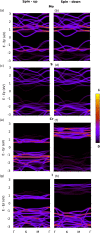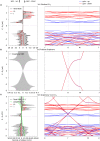Substrate induced electronic phase transitions of CrI[Formula: see text] based van der Waals heterostructures
- PMID: 33420187
- PMCID: PMC7794430
- DOI: 10.1038/s41598-020-80290-5
Substrate induced electronic phase transitions of CrI[Formula: see text] based van der Waals heterostructures
Abstract
We perform first principle density functional theory calculations to predict the substrate induced electronic phase transitions of CrI[Formula: see text] based 2-D heterostructures. We adsorb graphene and MoS[Formula: see text] on novel 2-D ferromagnetic semiconductor-CrI[Formula: see text] and investigate the electronic and magnetic properties of these heterostructures with and without spin orbit coupling (SOC). We find that when strained MoS[Formula: see text] is adsorbed on CrI[Formula: see text], the spin dependent band gap which is a characteristic of CrI[Formula: see text], ceases to remain. The bandgap of the heterostructure reduces drastically ([Formula: see text] 70%) and the heterostructure shows an indirect, spin-independent bandgap of [Formula: see text] 0.5 eV. The heterostructure remains magnetic (with and without SOC) with the magnetic moment localized primarily on CrI[Formula: see text]. Adsorption of graphene on CrI[Formula: see text] induces an electronic phase transition of the subsequent heterostructure to a ferromagnetic metal in both the spin configurations with magnetic moment localized on CrI[Formula: see text]. The SOC induced interaction opens a bandgap of [Formula: see text] 30 meV in the Dirac cone of graphene, which allows us to visualize Chern insulating states without reducing van der Waals gap.
Conflict of interest statement
The authors declare no competing interests.
Figures






Similar articles
-
Giant proximity exchange and flat Chern band in 2D magnet-semiconductor heterostructures.Sci Adv. 2023 Feb 24;9(8):eabn1401. doi: 10.1126/sciadv.abn1401. Epub 2023 Feb 24. Sci Adv. 2023. PMID: 36827369
-
Massive Dirac magnons in the three-dimensional honeycomb magnetic oxide [Formula: see text].Sci Rep. 2025 Feb 18;15(1):5978. doi: 10.1038/s41598-025-90478-2. Sci Rep. 2025. PMID: 39966561 Free PMC article.
-
Strain, electric-field and functionalization induced widely tunable electronic properties in MoS2/BC 3, /C 3 N and /[Formula: see text] van der Waals heterostructures.Nanotechnology. 2020 May 1;31(29):295202. doi: 10.1088/1361-6528/ab884e. Epub 2020 Apr 9. Nanotechnology. 2020. PMID: 32272455
-
Tunable 2D-gallium arsenide and graphene bandgaps in a graphene/GaAs heterostructure: an ab initio study.J Phys Condens Matter. 2019 Jul 3;31(26):265502. doi: 10.1088/1361-648X/ab0d70. Epub 2019 Mar 6. J Phys Condens Matter. 2019. PMID: 30840939
-
Valence band electronic structure of the van der Waals ferromagnetic insulators: VI and CrI.Sci Rep. 2020 Sep 24;10(1):15602. doi: 10.1038/s41598-020-72487-5. Sci Rep. 2020. PMID: 32973193 Free PMC article.
References
-
- Lee PA, Nagaosa N, Wen X-G. Doping a Mott insulator: Physics of high-temperature superconductivity. Rev. Mod. Phys. 2006;78:17–85. doi: 10.1103/RevModPhys.78.17. - DOI
-
- Mermin ND, Wagner H. Absence of ferromagnetism or antiferromagnetism in one- or two-dimensional isotropic Heisenberg models. Phys. Rev. Lett. 1966;17:1133–1136. doi: 10.1103/PhysRevLett.17.1133. - DOI
-
- Hartmann P, Donko Z, Bakshi PM, Kalman GJ, Kyrkos S. Molecular dynamics studies of solid–liquid phase transition in 2-D yukawa systems. IEEE Trans. Plasma Sci. 2007;35:332–336. doi: 10.1109/TPS.2007.894438. - DOI
Grants and funding
LinkOut - more resources
Full Text Sources
Other Literature Sources
Miscellaneous

